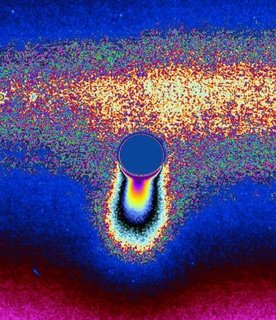Ice Jets Stream

The ice jets of Enceladus send particles streaming into space hundreds of kilometers above the south pole of this spectacularly active moon. Some of the particles escape to form the diffuse E ring around Saturn.
________________________________________________
Boosting the Signal Full-Resolution: PIA08226
July 21, 2006. For more information about:
the Cassini-Huygens mission visit http://saturn.jpl.nasa.gov/ .
The Cassini imaging team homepage is at http://ciclops.org/ .
Credit: NASA/JPL/Space Science Institute
________________________________________________
Cryovolcanism
Thanks to data from a number of instruments on the Cassini spacecraft during three encounters with Enceladus in 2005, cryovolcanism, where water and other volatiles are the materials erupted instead of silicate rock, has been discovered on Enceladus.
The combined analysis of imaging, mass spectrometry, and magnetospheric data suggests that the observed south polar plume emanates from pressurized sub-surface chambers, similar to geysers on Earth. [1]
Because no ammonia was found in the vented material by INMS or UVIS, which could act as an anti-freeze, such a heated, pressurized chamber would consist of nearly pure liquid water with a temperature of at least 270 K. Pure water would require more energy to melt, either from tidal or radiogenic sources, than an ammonia-water mixture.
Another possible method for generating a plume is sublimation of warm surface ice. During the July 14, 2005 flyby, the Composite Infrared Spectrometer (CIRS) found a warm region near the South Pole. Temperatures found in this region range from 85-90 K, to small areas with temperatures as high as 157 K, much too warm to be explained by solar heating, indicating that parts of the south polar region are heated from the interior of Enceladus. [5]
Ice at these temperatures is warm enough to sublimate at a much faster rate than the background surface, thus generating a plume. This hypothesis is attractive since the sub-surface layer heating the surface water ice could be an ammonia-water slurry at temperatures as low as 170 K, and thus not as much energy is required to produce the plume activity. However, the abundance of particles in the south polar plume favors the "cold geyser" model, as opposed to an ice sublimation model. [1]
Source: wikipedia Enceladus
_________________________________________________
More on Enceladus, Saturn's Rings & Moons
by Louise Riofrio @ riofriospacetime
_________________________________________________


<< Home